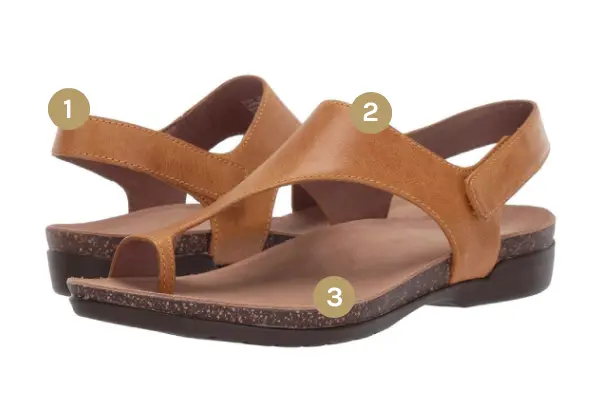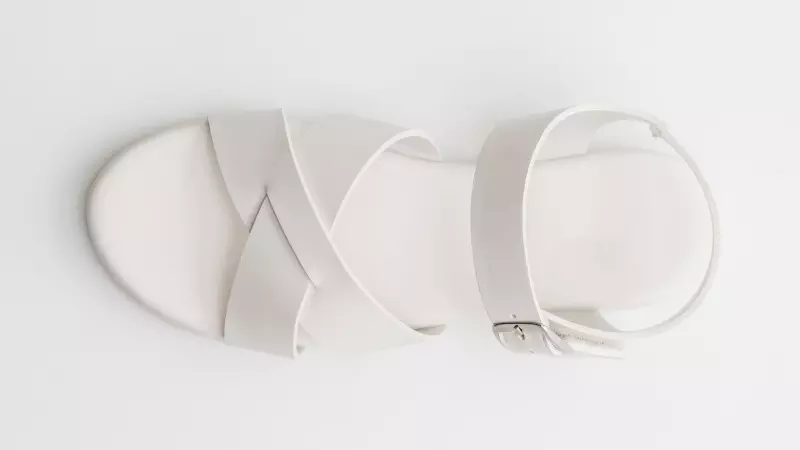How to Clean Leather Sandals in 4 Simple Steps
Leather sandals can help you make the ultimate fashion statement but are prone to getting dirty and grimy without proper care. The open design of the sandals can offer breathability even on the hottest days but can also be the reason why dirt, dust, and water can easily ruin their appearance.
If you use your leather sandals daily, you know just how easily they can get dirty due to grime, water stains, and dirt. The best way to clean leather sandals is to brush the dirt and dust off, clean the insoles or foodbed, upper part, and straps, nourish using a leather conditioner, and ventilate and dry them afterward.
This guide will help you with the entire process. Here’s a quick summary of how you can clean your leather sandals in 4 simple steps:
- Brush Off Dirt & Dust from Your Leather Sandals
- Clean the Upper, Straps & Insoles of Your Leather Sandals
- Condition Your Leather Sandals
- Ventilate & Dry Your Leather Sandals
You can also learn answers to the most frequently asked questions on the cleaning process and we’ve also made sure to share some of the best practices that you should consider. Let’s jump right in!
1. Brush Off Dirt & Dust from Your Leather Sandals
The first step is to brush away all embedded and tough dust that might be present in the nooks of your leather sandals. Begin this process by using a soft-bristled brush or a soft dry cloth to clean the surface of the sandals using gentle circular motions.
You can dampen the cloth slightly to remove any caked or remaining dirt spots. Use a steady and gentle hand while cleaning to avoid permanently scratching the leather surface.
This step will clean away any superficial debris on your leather sandals and prepare them for the cleaning that comes next.
2. Clean the Upper, Straps & Footbed of Your Leather Sandals
Some people are unsure of exactly what parts need to be cleaned on leather sandals – and also how each part is cleaned. We’ll make sure to break down each part so that you can follow the process step by step.
Important Tip: Please don’t clean leather sandals that are made of nubuck or suede with leather cleaners and conditioners. It’s best to use cleaning products that are specifically made for these types of fine leather.
To get a better understanding of each part of your leather sandals, have a look at the image with its respective description below.

Leather Sandal Description
- Sandal Strap
- Sandal Upper
- Sandal Insoles or Footbed
Before starting the cleaning process, it’s important to note that any type of harsh chemicals or excess water can damage the appearance of leather. Therefore, we highly recommend using only a leather-friendly cleaning solution or saddle soap for your leather sandals.
Our preferred choice for a leather-friendly cleaning solution is Kiwi Saddle Soap since it contains a mix of natural ingredients that work amazingly to clean, soften, and preserve the authentic texture of your leather sandals.
Although this guide solely focuses on cleaning leather sandals, it is possible that not every part of the sandal is made from leather. Most sandal footbeds are made of cork, for which you can use saddle soap or any gentle soap for cleaning.
If your sandals have a leather footbed, it is important that you only use saddle soap or a leather cleaner to clear away the grime and dirt. Any general cleaner may damage it, but more information on that later.
Cleaning the Leather Upper
Your leather sandal’s upper is the component that arches over the top of your foot. As leather sandals typically feature an upper that is made of leather, you’ll need to use an appropriate cleaning solution.
To clean the leather upper of your sandals, you need to lightly soak a soft cloth in warm water and dip it into saddle soap to create a lather. Apply the saddle soap gently to the leather surface using even circular motions. Repeat this process for all leather upper surfaces until you’re satisfied with the results.
Cleaning the Leather Strap
The leather strap is located towards the back of your sandals and is designed to wrap around the back of your heel. Similar to cleaning the upper of your leather sandals, you should clean the leather straps of your sandal using saddle soap with a damp cloth.
Ensure that you don’t use an excessively wet cloth for cleaning purposes as it might dry out the strap. Leather steps are usually thin in design, making them more susceptible to brittleness.
Here’s another tip, you can even use a soft-bristled toothbrush or any other type of brush for cleaning braided leather straps. This helps you get much better access to the crevices.
Cleaning the Leather Insoles or Footbed
Cleaning the leather insoles of your sandals will require a little bit of elbow grease since it is the part that absorbs the most sweat and accumulates dust. Leather sandals have insoles (sometimes referred to as footbeds) that are either made of cork, leather, or a combination of both.
We suggest using the same leather cleaning product used for the leather straps and upper part of the sandal, regardless of the footbed material. This is because saddle soap works wonders on cork, too.
With a damp cloth containing saddle soap, clean the leather footbed, outside edges, and stitches with small circular motions to remove grease, scuff marks, and any other types of dirt.
These steps will not only clean and wash your leather sandals but can also help remove any unpleasant smells. To learn tried-and-tested methods of removing odor, make sure to check out our detailed guide on how to remove odors from leather sandals.
3. Condition Your Leather Sandals
After cleaning your leather sandals using water and saddle soap or a suitable leather cleaner, you should nourish the material using mink oil or a dedicated leather conditioner.
We highly recommend using Sof Sole Mink Oil for adding a waterproof layer to your leather sandals. Mink oil is great for leather sandals because it also helps to moisturize them, giving them a polished appearance.
For a more protective alternative, you can opt for Leather Honey Leather Conditioner, which is another one of our favorites. It penetrates the porous material to offer long-lasting shine and preservation for your leather sandals.
How to Use a Conditioner on Your Leather Sandals
Use a soft dry cloth to apply a thin coat of leather conditioner or mink oil on the leather surface of your sandals. A leather conditioner preserves the color and texture of your sandals and prevents them from getting damaged easily by moisture, water, or direct sunlight.
Ensure never to use excessive leather conditioner as it can affect the breathability and texture of your leather sandals.
4. Ventilate & Dry Your Leather Sandals
Once your leather sandals are cleaned to your satisfaction, you can leave them in a well-ventilated area to air dry. Leather can easily entrap musty odors and even shrink if left wet.
You should ensure never to put them under direct sunlight, as it can make the leather brittle and cause cracks. We recommend putting them under shaded areas such as a verandah, near a large fan, an outdoor shoe rack, in the garden, or similar locations.
Useful Tips When It Comes to Cleaning Leather Sandals
Cleaning leather sandals is quite straightforward, but a few tips and tricks can help you preserve your sandals for much longer.
- Let Them Dry Before Wearing – Always allow your leather sandals to dry completely before use. This helps prevent any creases and cracks in your leather footwear and ensures the dampness doesn’t attract more dirt or, worse, mold.
- Use Leather-Friendly Products – Leather is a porous and natural material that requires careful maintenance for optimum results. Using only leather-friendly products ensures you can avoid any discoloration or change in texture due to acetone or alcohol ingredients.
- Store Them Correctly – Leather sandals must be stored in a dry, cool, and well-ventilated environment to avoid mold and cracking due to the heat. Damp environments also promote bacterial growth.
Frequently Asked Questions
Understanding that you may have some questions with regards to cleaning your leather sandals, we’ve created a list of the most frequently asked ones. Please feel free to write in if you wish to have your questions added.
Can I Wash My Leather Sandals in the Washing Machine?
No, you should never wash leather sandals in the washing machine since full immersion of the leather footwear and the water pressure in the washing machine can damage it permanently.
Although your leather sandals may look clean at first, right after using a washing machine, the fiber structure and texture of the leather may warp irreversibly as it dries. They may also experience significant shrinkage, so avoid using a washing machine at all costs.
Can I Place My Leather Sandals in a Dryer?
No, you should never place leather sandals in a dryer since the heat can cause them to lose their durability and become less flexible. It can also dry out the material and even cause it to lose its original shape. The tumbling will also cause them to crease and wrinkle.
How Do I Clean White Leather Sandals?
You can use the steps above to clean white leather sandals. The only difference with these particular sandals is that the dirt and scuff marks on them are more visible, which may require you to be more diligent with the cleaning process. Nevertheless, the same products, tools, and methods can be used, as mentioned in the guide above.
How To I Remove Scratches and Scuff Marks From My Leather Sandals
If you spot any scratches or scuff marks on your leather sandals, you’ll need to use a brush during the cleaning process. Use a little more pressure to brush them off using saddle soap or a suitable leather cleaning solution.
How Do I Clean Leather Sandals Made of Suede or Nubuck
Please note that you shouldn’t use any type of leather cleaner or conditioner that isn’t made to treat fine leathers such as suede or nubuck. To clean suede or nubuck sandals, you’ll need to use a suitable cleaner such as Shoe MGK’s Shoe Cleaner Kit.
Fine leathers require extra care, throughout the entire cleaning process. If you use general cleaners or cleaning solutions that are designed for other leather types, your suede or nubuck leather sandals may permanently lose their fine texture. Please keep this in mind!

About Gerrit
Co-Founder, Researcher & Writer At Leatherskill
I’m a leather enthusiast who spends most of his free time crafting, researching, and writing about the many facets of this versatile material. Thanks for reading!

